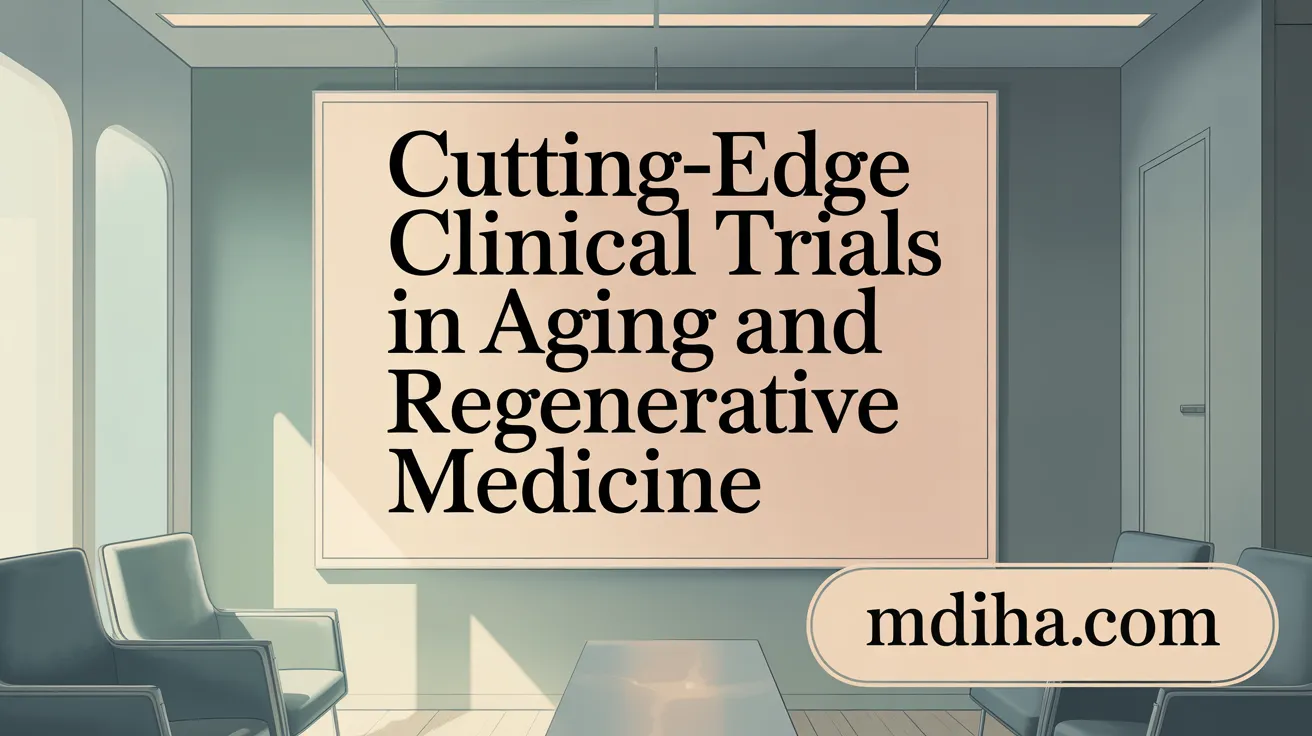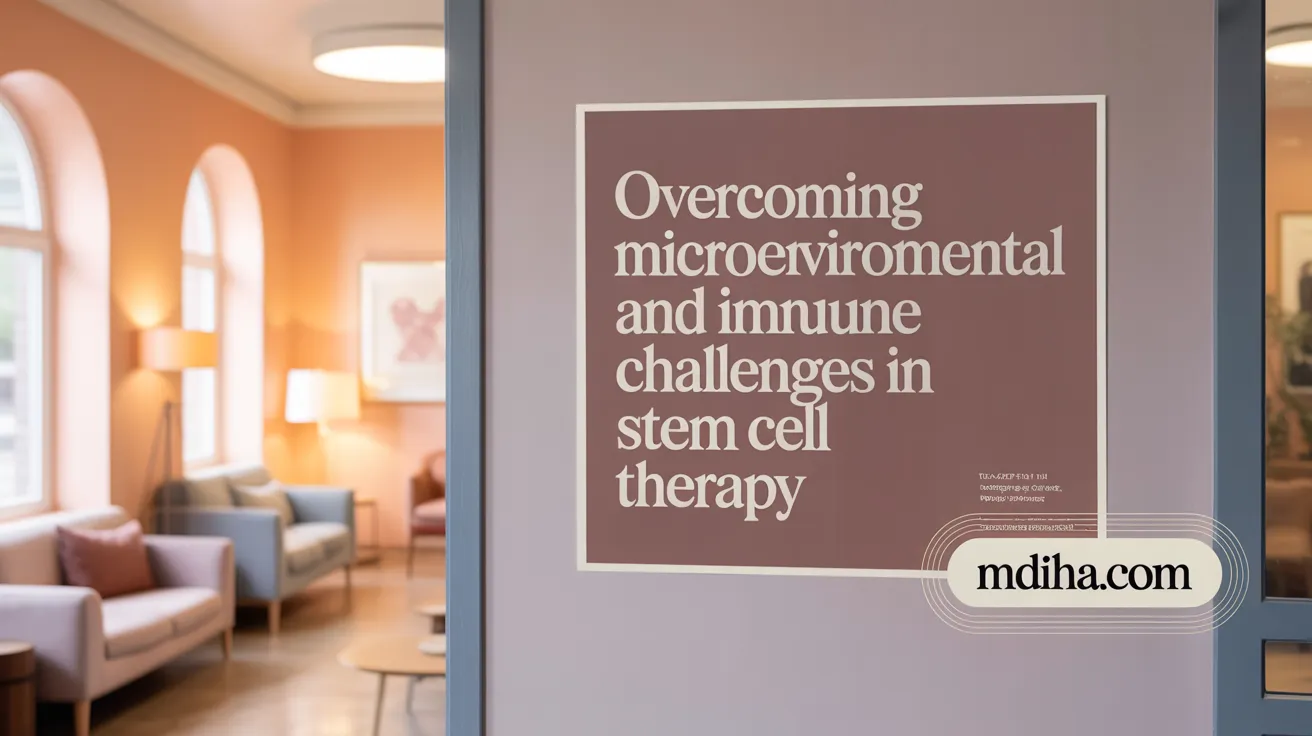Introduction to Stem Cell Therapy in Addressing Age-Related Conditions
Overview of Stem Cell Capabilities
Stem cells are intrinsic to the body's regenerative system due to their ability to self-renew and differentiate into various specialized cell types. These dual properties enable the replacement and repair of damaged tissues, making stem cells fundamental to regenerative medicine approaches aimed at mitigating the effects of aging.
Historical Milestones in Stem Cell Research
The field began with the isolation of embryonic stem cells (ESCs) in 1981, revealing pluripotent cells capable of developing into any human tissue. A major breakthrough came in 2007 with the discovery of induced pluripotent stem cells (iPSCs), adult cells reprogrammed back into a pluripotent state, thus bypassing ethical concerns associated with ESCs and enabling personalized therapies.
Broad Applications in Age-Related Conditions
Stem cell therapies are being extensively explored for their potential to treat a spectrum of age-related ailments including neurodegenerative disorders like Parkinson’s and Alzheimer’s diseases, cardiovascular diseases, osteoarthritis, and diabetes. Clinical trials currently evaluate stem cell interventions to rejuvenate tissues, repair organ damage, and improve physiological functions diminished by aging.
Unique Properties of Stem Cells Relevant to Aging
Beyond differentiation, stem cells exert paracrine effects through secretion of bioactive factors and exosomes that modulate immune responses, reduce inflammation, and stimulate endogenous repair mechanisms. This dual regenerative and immunomodulatory role positions stem cells as promising agents to counteract aging-associated decline in tissue homeostasis and support extended healthspan.
Diverse Stem Cell Types and Their Roles in Regenerative Medicine

What are the main types of stem cells used in therapy and their characteristics?
Stem cell therapy employs several distinct types of stem cells, each with unique properties and therapeutic potentials. These include:
-
Embryonic Stem Cells (ESCs): Derived from early-stage embryos, ESCs are pluripotent, possessing the ability to differentiate into any human cell type. Their high self-renewal capacity makes them valuable for tissue regeneration, disease modeling, and drug discovery. However, their use is ethically debated.
-
Adult Stem Cells (ASCs): These are multipotent stem cells found in specific tissues like bone marrow, adipose tissue, and muscle. They primarily support tissue-specific regeneration and repair. [Mesenchymal stem cells (MSCs)], a widely studied subset of ASCs, possess regenerative and immunomodulatory functions crucial for anti-aging therapies.
-
Perinatal Stem Cells: Sourced from the placenta, umbilical cord, and amniotic fluid, perinatal stem cells display hybrid multipotent capabilities. They offer ethical advantages over embryonic cells and exhibit immunological tolerance, making them suitable for allogeneic transplantation.
-
Induced Pluripotent Stem Cells (iPSCs): Reprogrammed from adult somatic cells, iPSCs mirror the pluripotency of ESCs without ethical concerns related to embryo use. They enable personalized medicine applications, including disease modeling and drug screening.
Comparative Advantages and Applications in Age-Related Therapies
ESCs provide broad differentiation potential but face ethical and immunogenicity limitations. ASCs and MSCs are favored for their safety profile and immunomodulatory secretome, contributing to tissue repair, inflammation reduction, and cellular rejuvenation. Perinatal stem cells combine multipotency with reduced ethical concerns and immune rejection risk.
Immune modulation strategies are a key function of MSCs, which secrete cytokines, growth factors, and exosome-based therapeutics that facilitate angiogenesis, reduce fibrosis, modulate immune responses, and counter oxidative stress. iPSCs contribute by offering regenerative solutions for neural, cardiac, and pancreatic tissues, with clinical advances in conditions like Parkinson’s disease and diabetes.
These varied stem cell types collectively underpin regenerative medicine’s capacity to restore function and vitality across degenerative and aging-related conditions, supporting the extension of healthspan through personalized interventions.
Mesenchymal Stem Cells: The Cornerstone of Anti-Aging Therapies

How do mesenchymal stem cells contribute to anti-aging effects?
Mesenchymal stem cells (MSCs) are multipotent adult stem cells capable of differentiating into several specialized cell types, including osteoblasts (bone cells), chondrocytes (cartilage cells), myoblasts (muscle cells), adipocytes (fat cells), and fibroblasts (connective tissue cells). This differentiation ability enables MSCs to directly participate in tissue repair and regeneration across various aging-affected systems (Mesenchymal Stem Cells Benefits, Anti-aging stem cell therapy).
Beyond differentiation, MSCs secrete a rich secretome composed of cytokines, growth factors, and extracellular vesicles such as exosome-based therapeutics. These bioactive molecules act in a paracrine manner to promote angiogenesis, enhancing blood supply to tissues, which is vital for regeneration and maintaining aged organ function (MSC secretome functions, Exosome-based therapeutics, stem cell niche rejuvenation).
Immunomodulatory properties of MSCs help shift immune cells from a pro-inflammatory to an anti-inflammatory state, limiting tissue damage from persistent inflammation. Moreover, MSCs inhibit apoptosis (programmed cell death) of native cells and encourage remodeling of the extracellular matrix, maintaining tissue elasticity and integrity (immunomodulation by MSCs, immune modulation strategies, immune modulation strategies.
MSCs also combat oxidative stress, one of the main drivers of cellular aging, by carrying antioxidant enzymes within their secreted vesicles. They support mitochondrial function and enhance energy production, improving cellular resilience. By regulating cellular senescence and sustaining stem cell niche rejuvenation, MSCs bolster endogenous regenerative capacity, making them fundamental agents in anti-aging therapies (MSC antioxidant properties, stem cells in tissue regeneration).
In summary, MSCs contribute to anti-aging by leveraging their multi-lineage differentiation, secreting regenerative and immunomodulatory factors via their secretome and exosome release roles, promoting vascular growth and mitochondrial health, and rebalancing the immune landscape to restore tissue homeostasis and vitality (Stem Cell Therapy for Anti-Aging, Regenerative Power of Stem Cells.
Harnessing Induced Pluripotent Stem Cells for Personalized Age-Related Therapies

What are induced pluripotent stem cells (iPSCs) and how are they generated?
Induced pluripotent stem cells (iPSCs) are adult somatic cells reprogrammed back into a pluripotent state, which means they can differentiate into virtually any cell type in the human body. This reprogramming process involves introducing specific transcription factors that reset the adult cells' identity, allowing them to mirror embryonic stem cells (ESCs) in their developmental versatility.
How are iPSCs applied therapeutically in diabetes and neurodegenerative diseases?
iPSCs hold remarkable promise for personalized treatment of age-related conditions. In diabetes, notably Type 1, iPSC-derived insulin-producing cells have been successfully transplanted to restore glycemic control, eliminating the need for exogenous insulin in some patients. In neurodegenerative disorders like Parkinson’s and Alzheimer’s diseases, iPSC-derived neural stem cells aim to replace damaged neurons and reduce neuroinflammation, offering potential symptom relief and functional restoration.
What advantages do iPSCs offer compared to embryonic stem cells?
Unlike embryonic stem cells, iPSCs circumvent ethical dilemmas as they do not involve the destruction of embryos. When derived from the patient’s own tissue, iPSCs minimize the risk of immune rejection, enhancing compatibility and safety. This autologous nature also allows for personalized regenerative therapies tailored specifically to the patient’s genetic background (precision medicine and stem cells).
What challenges and clinical trials are associated with iPSC therapies?
Despite their potential, iPSC therapies face hurdles such as tumorigenicity risk posed by residual undifferentiated cells, difficulties in large-scale production, and high manufacturing costs. Current clinical trials have demonstrated safety and preliminary efficacy in applications including eye diseases, neurodegeneration, and diabetes. Regulatory oversight and technological advancements like CRISPR gene editing are expected to improve therapeutic safety and effectiveness.
| Aspect | Details | Significance |
|---|---|---|
| Generation | Reprogramming adult cells via transcription factors | Creates pluripotent cells capable of diverse differentiation (induced pluripotent stem cells (iPSCs) |
| Therapeutic Applications | Type 1 diabetes (insulin-producing cells), neurodegenerative diseases (neural stem cells) | Personalized disease modeling and treatment (iPSCs for diabetes and neurodegeneration) |
| Advantages | Ethical acceptability, reduced immune rejection | Facilitates personalized regenerative medicine (ethical advantages of iPSCs |
| Challenges | Tumorigenesis, scalability, cost | Necessitates rigorous control and improved manufacturing (tumorigenesis in stem cell use, challenges in iPSC therapies |
| Clinical Trials | Ongoing studies in diabetes, neurodegeneration, eye diseases | Early demonstration of safety and potential efficacy (clinical trials with iPSCs |
Innovations in Gene Editing and Biotechnology Enhancing Stem Cell Therapy

How are recent biotechnological advances improving stem cell therapies?
Recent biotechnological advancements have significantly enhanced the precision, efficacy, and safety of stem cell therapies, ushering in a new era in regenerative medicine.
One of the most transformative tools is the CRISPR gene editing (CRISPR-Cas9) technology. This powerful method allows for exact genetic modifications in stem cells, correcting disease-causing mutations and enabling personalized treatment strategies. CRISPR enhances the therapeutic potential of both embryonic stem cells (ESCs) and induced pluripotent stem cells (iPSCs) by enabling precise manipulation of cell behavior and differentiation potential.
Exosome-based therapeutics represent another cutting-edge advancement. These nano-scale vesicles, secreted by stem cells, transport growth factors, proteins, and nucleic acids that modulate immune responses, promote tissue repair, and reduce inflammation. Unlike direct stem cell transplantations, exosome therapies minimize risks such as immune rejection and tumorigenesis, offering a safer approach to deliver regenerative cues at the cellular level.
Single-cell RNA sequencing has revolutionized stem cell research by allowing an in-depth profiling of gene expression at the individual cell level. This technology uncovers the heterogeneity within stem cell populations and tracks differentiation pathways with unprecedented resolution, facilitating the development of more targeted and effective regenerative therapies.
Furthermore, synthetic biology techniques, including the introduction of molecular suicide switches, provide robust safety mechanisms. These engineered systems enable controlled elimination of transplanted stem cells if aberrant proliferation or tumorigenesis occurs, addressing one of the major challenges hindering clinical applications.
Together, these biotechnological advances are propelling stem cell therapies toward a future of precision, safety, and enhanced regenerative capacity, with broad applications across aging, degenerative diseases, and tissue engineering.
Stem Cell Therapeutics for Neurodegenerative and Cardiovascular Diseases

What is the state of stem cell therapies for neurodegenerative and cardiovascular conditions?
Stem cell therapies targeting neurodegenerative disorders such as Parkinson’s and Alzheimer’s diseases focus on regenerating damaged neurons and mitigating neuroinflammation. Approaches include transplantation of pluripotent stem cell–derived neurons and replacement of brain immune cells like microglia. Microglial cell replacement therapy uses stem cells to restore brain immune function, potentially slowing neurodegeneration by replenishing dysfunctional microglia, as demonstrated in promising animal and preclinical models.
In Alzheimer’s, mesenchymal stem cell (MSC) therapy has shown potential to reduce inflammation and tissue loss following administration. Additionally, human brain organoids derived from induced pluripotent stem cells (iPSCs) serve as advanced models to study disease pathology and test drugs, enhancing understanding and development of therapies.
Cardiovascular regenerative therapies leverage MSCs, cardiac progenitor cells (CPCs), embryonic stem cells (ESCs), and induced pluripotent stem cells (iPSCs) to repair damaged cardiac tissues, improve heart function, and limit fibrosis after injury. These cells exhibit abilities to differentiate into cardiomyocytes and secrete growth factors that promote tissue regeneration.
Clinical trials in both neurological and cardiovascular fields have demonstrated promising safety profiles and early efficacy signals, reflected by improvements in clinical symptoms and biomarkers. Nonetheless, longer-term and larger-scale studies are necessary to confirm therapeutic benefits, optimize cell sources, delivery methods, and ensure durable outcomes.
Recent technological advances complement these efforts, including advanced gene editing and exosome-based therapeutics, aiming to enhance treatment precision and mitigate risks such as tumorigenesis or immune rejection.
Clinical Trials Advancing Stem Cell Applications in Aging and Frailty

What are the recent clinical trial developments for stem cell therapy in aging?
Recent clinical trials have spotlighted mesenchymal stem cell (MSC) therapies as promising interventions for aging-related conditions such as physical frailty and skin aging.
Mesenchymal stem cell trials for physical frailty
Lomecel-B, an allogeneic bone marrow-derived MSC preparation, has shown encouraging phase II results. Treated elderly subjects exhibited improved physical endurance measured by increased 6-minute walk distances and notable reductions in systemic inflammatory markers. These findings underscore MSCs' immunomodulatory and regenerative potential in restoring functional capacity in frail populations.
Stem cell treatments for skin rejuvenation
Clinical investigations using autologous adipose-derived stem cells have revealed significant improvements in skin quality, including reduced wrinkles, brightness enhancement, and improved texture. These effects are attributed to enhanced collagen production and extracellular matrix remodeling stimulated by MSC secretomes.
Safety considerations and dosing optimization
While MSC therapies are generally well-tolerated, concerns such as pulmonary cell entrapment following intravenous administration necessitate careful dose and delivery method optimization. Long-term safety monitoring remains a critical component of these trials. See further discussion on safety and efficacy challenges of MSC therapy.
Emerging standardized protocols
Current research efforts emphasize the establishment of standardized protocols encompassing MSC source selection, cell dosage, and administration techniques. This aims to maximize therapeutic efficacy, reproducibility, and safety across diverse patient demographics. Learn more about standardization and delivery of MSCs.
These clinical developments collectively suggest that MSC therapies hold considerable promise in mitigating aging phenotypes and enhancing healthspan, though further large-scale, controlled studies are required to consolidate these findings and guide clinical practice.
Overcoming Challenges: Immunological Rejection, Tumorigenesis, and Microenvironmental Factors

What challenges exist in stem cell therapies for older patients?
Stem cell therapies in older individuals face multifaceted challenges largely stemming from interactions with the immune system and the aging microenvironment. Immunological rejection remains a primary concern as the host immune system may recognize transplanted stem cells as foreign, particularly with allogeneic sources, leading to decreased engraftment and efficacy (immune rejection issues.
Another critical issue is the risk of tumorigenesis due to residual undifferentiated pluripotent stem cells. These cells can proliferate uncontrolled, potentially forming tumors if not thoroughly matured or purified before transplantation.
Furthermore, aging significantly alters the stem cell niche—the specialized tissue microenvironment supporting stem cell function. Research reveals that aged niches exhibit diminished supportive signals and structural changes, impeding stem cell differentiation and regeneration (stem cell niche rejuvenation. This may cause transplanted cells to falter or differentiate improperly, thus limiting therapeutic success in older patients.
Strategies to improve engraftment and safety
To overcome immune rejection, immune modulation strategies are employed, including co-transplantation with immunosuppressants or using immune-compatible induced pluripotent stem cells (iPSCs) derived from patient tissues to reduce immunogenicity.
Gene editing technologies like CRISPR-Cas9 are advancing the safety profile of stem cell therapies by enabling the removal of oncogenic potential and enhancing controlled differentiation.
Non-genotoxic conditioning regimens have shown promise for facilitating stem cell engraftment with less toxicity, especially in hematopoietic stem cell therapies, improving transplant success in aged individuals.
Rejuvenation of the stem cell niche through systemic interventions or local modulation is another emerging approach, restoring the environment’s capacity to support stem cell activity and promoting better integration and function of transplanted cells.
Collectively, integrating immune regulation, advanced gene editing, and niche rejuvenation presents a comprehensive framework to address current obstacles in stem-cell therapy for older populations, aiming at safer and more effective regenerative outcomes.
Immune Cell-Based Therapies Targeting Immunosenescence and Aging

Role of NK Cells and CAR-T Cells in Senescent Cell Clearance
Immune cell therapies are increasingly recognized for their potential to combat aging by targeting immunosenescence—the decline in immune function associated with aging. Natural killer (NK) cells and chimeric antigen receptor T (CAR-T) cells have emerged as innovative tools to selectively eliminate senescent cells that accumulate with age and contribute to systemic inflammation. Engineered CAR-T cells can be designed to recognize specific markers such as uPAR and NKG2D ligands on senescent cells, effectively clearing these dysfunctional cells in preclinical models. Similarly, adoptive transfer of NK cells enhances immune surveillance and reduces senescent immune cell populations, potentially restoring youthful immune function (immune modulation strategies.
Immunomodulatory Effects of Stem and Immune Cells
Stem cells, particularly mesenchymal stem cells (MSCs), contribute to immune regulation through secretion of cytokines, growth factors, and extracellular vesicles such as exosome-based therapeutics. These factors modulate inflammation, promote tissue regeneration, and inhibit apoptosis, thus complementing immune cell therapies. MSC-derived exosomes have demonstrated inhibition of T-cell senescence by delivering microRNA-21 and activating antioxidant pathways. The combined use of stem cells and immune cell therapies fosters an environment conducive to immune homeostasis and rejuvenation, which is critical in mitigating chronic inflammation and tissue degeneration that characterize aging (immunomodulation by stem cells.
Therapeutic Implications for Age-Related Diseases
The convergence of stem and immune cell therapies offers promising interventions for age-related disorders, including neurodegenerative diseases, cardiovascular conditions, and frailty. Early clinical trials using allogeneic MSCs (e.g., Lomecel-B) have shown improvements in physical performance and reductions in inflammatory markers in elderly populations. Parallel studies with NK and CAR-T cells aim to reduce senescence burden, potentially delaying the onset or progression of diseases such as Alzheimer's and autoimmune disorders. These therapies represent a shift toward addressing the underlying cellular dysfunction in aging rather than merely managing symptoms (stem cell therapies for anti-aging).
Safety and Efficacy Considerations
While immune cell-based and stem cell therapies hold tremendous potential, safety and efficacy remain paramount. Risks such as tumorigenesis from residual pluripotent cells and inflammatory side effects like cytokine release syndrome must be carefully managed. Advances in rigorous cell manufacturing, standardized protocols, and use of MSC-derived exosomes as safer alternatives are helping to mitigate these challenges. Ongoing clinical trials and improved delivery systems aim to optimize therapeutic outcomes while minimizing adverse events.
The integration of immune cell therapies with stem cell approaches represents a cutting-edge strategy in the pursuit of extending healthspan and combating immunosenescence effectively.
Bioengineering and Tissue Regeneration: Towards Functional Organs and Complex Tissues

What are the latest bioengineering strategies enhancing stem cell regenerative potential?
Recent advances in bioengineering have markedly expanded the regenerative potential of stem cells, highlighting innovative strategies that could revolutionize treatment for age-related tissue degeneration.
One such strategy is the development of organoid technology. Organoids are miniature, three-dimensional structures grown from stem cells that closely mimic the architecture and function of human organs. They serve as powerful disease models and facilitate drug testing while opening new avenues for tissue regeneration. For instance, researchers have successfully grown kidney and blood-forming heart organoids that represent promising steps towards organ regeneration.
Another emerging approach is 3D bioprinting coupled with advanced scaffolding materials. This technique enables the precise layering of stem cells and biomaterials to construct complex tissues that replicate native tissue microenvironment. When integrated with gene editing technologies like CRISPR, 3D bioprinting offers the potential to produce functional tissue constructs tailored to individual patients, thereby advancing personalized regenerative medicine.
Insights from stem cell research conducted in microgravity environments, such as aboard the International Space Station, have revealed unique cellular behaviors that enhance regenerative capacity. Microgravity conditions appear to strengthen the stem cells' functionality, offering critical understanding that could be translated into improved regenerative therapies on Earth.
Looking forward, these bioengineering innovations collectively promise to reduce dependence on organ donors by enabling the fabrication of functional tissues and organs. They also signal a future where tissue engineering can effectively address the systemic effects of aging, improving healthspan and quality of life through restoration of organ function and repair of complex tissue damage.
Anti-Aging Mechanisms of Stem Cell Therapy: From Cellular Senescence to Metabolism

How does stem cell therapy directly combat aging at the cellular level?
Stem cell therapy, especially involving mesenchymal stem cells (MSCs), targets fundamental aging processes at the cellular scale. One crucial mechanism is the modulation of cellular senescence — MSCs inhibit pathways that drive cells toward aging and programmed death, thereby maintaining healthier cell populations.
Modulation of cellular senescence by MSCs
MSCs secrete cytokines, microRNAs, and exosome-based therapeutics that deliver regenerative signals. These components reduce accumulation of senescent cells by repressing senescence-associated secretory phenotypes, restoring cellular homeostasis and promoting stem cell niche rejuvenation.
Stem cell impact on mitochondrial function and oxidative stress
MSCs enhance mitochondrial efficiency, boosting cellular energy production. They also supply antioxidant enzymes through extracellular vesicles, mitigating oxidative stress — a major contributor to aging-related cellular damage (anti-inflammatory properties of stem cells).
Secretion of growth factors and anti-inflammatory mediators
Stem cells release growth factors such as VEGF and TGF-β, facilitating angiogenesis and tissue repair. Their secretome also exerts powerful immune modulation strategies, shifting macrophages to an anti-inflammatory phenotype, which dampens chronic inflammation linked to aging.
Enhancement of extracellular matrix and tissue elasticity
MSC secretions promote extracellular matrix remodeling by stimulating collagen production and inhibiting fibrosis. This preserves tissue structure and elasticity, critical for maintaining youthful function in skin, joints, and organs (collagen production and skin elasticity.
These integrated actions of stem cell therapy address multiple interlinked pathways of aging, enabling improved regenerative capacity, tissue integrity, and systemic health vital for extending healthspan and mitigating age-related decline.
Clinical Implementation and Personalized Regenerative Medicine Approaches

How are stem cell therapies personalized and safely implemented in clinical settings?
Personalized stem cell therapy begins with a comprehensive patient evaluation that considers factors such as age, underlying health conditions, and the specific medical issues requiring intervention. This tailored approach ensures that treatment protocols are optimized for individual biological contexts.
Stem cells are most commonly harvested from the patient’s adipose tissue or bone marrow, leveraging autologous sources to minimize immunological risks. The harvesting process is followed by cell processing and expansion within ISO-certified cleanrooms adhering to stringent sterility and quality controls. This ensures high-quality, viable cells free from contamination.
To maximize therapeutic efficacy, stem cell treatments are frequently combined with exosome therapy, which utilizes vesicles rich in growth factors and signaling molecules to augment tissue repair and immune modulation. Additionally, therapeutic plasma exchange may be employed to reduce systemic inflammatory proteins and toxins, further supporting regenerative outcomes.
Qualified and experienced medical teams administer these therapies, carefully monitoring patients for any mild side effects, such as transient swelling or fatigue, while ensuring safety through adherence to established clinical protocols. Treatment dosing and delivery routes are customized for each patient, contributing to durable benefits that may extend from months to years.
This integrated and personalized framework for regenerative medicine underscores the importance of certified facilities and expert clinical oversight in achieving safe, effective interventions tailored to individual patient needs.
Cost, Accessibility, and Ethical Considerations in Stem Cell Anti-Aging Treatments

What are the current cost and ethical considerations surrounding stem cell therapies for aging?
Stem cell therapies targeting anti-aging and regenerative goals exhibit significant variability in cost. Treatment expenses commonly range from approximately $4,000 for basic autologous stem cell procedures to upwards of $30,000 for more complex interventions involving expanded or allogeneic stem cells and advanced delivery methods (Stem Cell Therapy for Anti-Aging.
The financial investment largely depends on factors such as the source of stem cells (adipose, bone marrow, umbilical cord, or induced pluripotent stem cells (iPSCs), processing techniques, and the clinical setting (Anti-aging stem cell therapy, Stem cell therapy overview). Patients should consider these costs in the context of treatment complexity and follow-up care requirements.
Ethical considerations primarily concern the use of embryonic stem cells (ESCs), which involve destruction of human embryos and raise moral and legal questions. This has led to stringent regulatory restrictions in many countries. Alternatively, adult stem cells and induced pluripotent stem cells (iPSCs) present ethically acceptable options as they avoid embryo usage by reprogramming somatic cells or using adult tissue-derived stem cells (Ethical considerations in stem-cell research, Stem cells and ethical issues.
Regulatory landscapes are continuously evolving. Currently, the United States Food and Drug Administration (FDA) has approved only hematopoietic stem cell transplantation for blood and immune disorders. Anti-aging stem cell therapies remain investigational, often conducted within clinical trials in stem cell therapy to ensure rigor, safety, and demonstrable efficacy (FDA-approved stem cell therapies, Clinical trials in stem cell therapy.
Participating in controlled clinical trials is crucial for advancing stem cell anti-aging therapies. Standardization in stem cell preparation, dosing, administration, and long-term monitoring remains essential to minimize risks such as tumorigenesis or immune rejection and to verify therapeutic benefits (Challenges in stem cell therapy, Safety and efficacy in stem-cell therapy).
In summary, cost considerations, careful ethical sourcing, and adherence to regulatory oversight are vital components in the responsible development and clinical application of stem cell therapies aimed at enhancing healthspan and mitigating age-related decline (Future prospects of stem-cell therapy, Stem cell therapy benefits).
Future Outlook: Integrating Advanced Stem Cell Therapies for Healthy Aging
Emerging Research Directions
Recent advancements in stem cell science focus on precise manipulation and combination therapies. Innovations such as CRISPR gene editing enable targeted correction of mutations, while single-cell RNA sequencing refines understanding of stem cell heterogeneity and function. Engineered immune cells like CAR-T and natural killer (NK) cells show promise in clearing senescent cells, addressing immunosenescence to rejuvenate immune function.
Multimodal Regenerative Approaches
Integrative strategies combine mesenchymal stem cells (MSCs), hematopoietic stem cells (HSCs), and exosome therapy to enhance tissue repair, modulate inflammation, and support systemic regeneration. Bioengineering techniques aiming to produce functional tissues and organs complement these therapies, offering solutions for age-related tissue degeneration.
Expanding Clinical Trials and Personalized Medicine
Clinical trials increasingly explore stem cell therapies for frailty, neurodegenerative diseases, cardiovascular conditions, and skin aging, revealing improvements in physical capacity and cognitive function. Personalized approaches leverage induced pluripotent stem cells (iPSCs) derived from patient cells, minimizing immune rejection and optimizing therapy efficacy.
Potential to Transform Longevity and Quality of Life
Advanced stem cell interventions hold the promise to extend healthspan by restoring regenerative capacity, lowering inflammation, and enhancing metabolic function. The convergence of gene editing, immune modulation, and regenerative medicine is poised to revolutionize aging management, enabling sustained vitality and improved quality of life for older adults.
